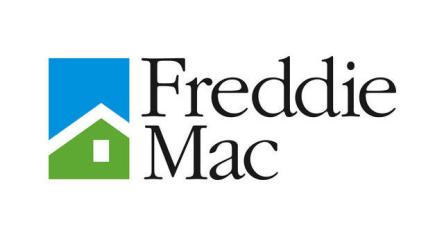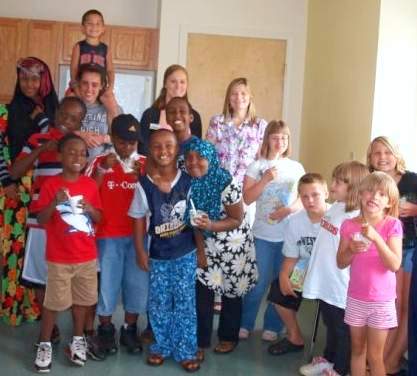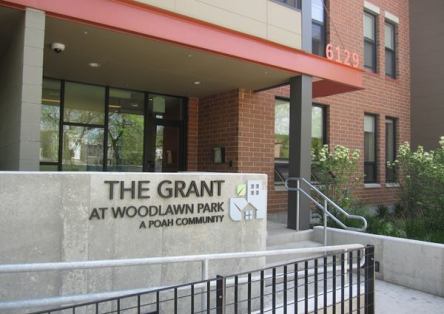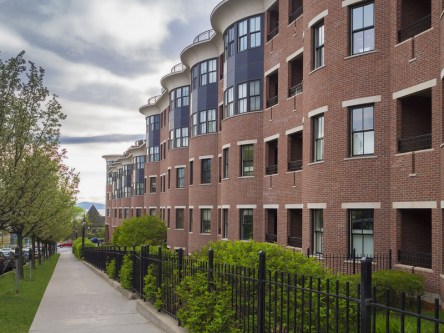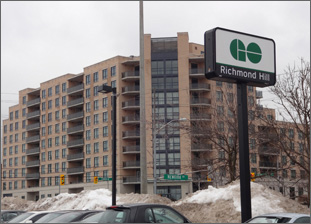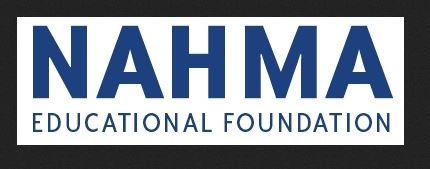While the ghosts of the last decade’s housing crisis have (mostly) been put to rest, for many families priced out of their local markets the need for affordable housing remains strong. Like the PC’s infamous “blue screen of death,” the Urban Institute’s map of affordable housing inventory is terrifying to behold. A handful of dark blue swatches in Midwest represent healthy levels of affordable housing inventory. The rest of the country, on the other hand, sits awash in the lightest indigo hues. From barely perceptible azure to the palest cerulean, a majority of states contain less than 50 units per 100 extremely low-income households. More than a third sit at, or close, to zero. As demand for budget-friendly rentals continues to rise, many communities struggle to provide adequate supply. In response to this affordable housing crisis, the White House recently released the Housing Development Toolkit. Part call to action, part policy overhaul, the toolkit’s main purpose it to help cities increase their affordable housing inventory. “The growing severity of unsupplied housing markets is jeopardizing housing affordability for working families,” write the toolkit’s authors, “increasing income inequality by reducing less-skilled workers’ access to high-wage labor markets, and stifling GDP growth by driving labor migration away from the most productive regions,” Accumulated Barriers While New York City’s real estate market is the stuff of legend, until recently most cities were able to supply adequate housing to residents. Unfortunately, several factors have conspired over the last few years to shrink stock and ramp up costs. These “accumulated barriers” are identified by the toolkit as lack of adequate construction, high job growth in areas with low vacancy rates, gentrification, and cost-per-unit increases paired with insufficient public assistance. “The accumulation of these barriers has reduced the ability of many housing markets to...
Redtail Ponds
A Place to Call Home
The first thing you notice when you visit the Redtail Ponds housing community in Fort Collins is how many residents have dogs. There are big ones and small ones, bulldogs and collies, mutts and mixes. Residents of the community proudly walk their pets in and out of the building’s front door, into a brisk fall Colorado day. Not long ago, the majority of the 60 residents of Redtail Ponds were spending all of their time outside – or in vehicles, temporary shelters, or on the streets of Fort Collins. Some were homeless for years, other for decades. Now, they have homes. “For 46 years of my life I struggled, and in the past two years I feel like I have probably come farther in my life than I ever have. And I owe that to Redtail Ponds,” said Tom Campbell, a resident of the community. We were visiting Redtail Ponds to make a video about the community’s life-changing impact on the local homeless community. You can view that video here: There’s much more to the Redtail Ponds story, and it starts with the story of Housing Catalyst, the non-profit affordable housing developer that constructed Redtail Ponds and is working on more permanent supportive housing for Northern Colorado. Zachary Penland, Program Manager at Redtail Ponds and a dedicated advocate for the homeless in Fort Collins, explained: “People sign a lease, and they can stay as long as they want, as long as they are abiding by that lease. What makes it different is supportive services. It is specifically tailored for individuals who have experienced homelessness and have a long term disability. We recognize that with those additional barriers, simply handing them a set of keys, saying good luck and walking away isn’t going to be enough. They need that ongoing support to be successful in their housing. We provide that onsite support so that they can ultimately be successful in their new homes.” On site supportive services include mental health counseling, job assistance, veterans services, AA meetings, benefit consultations, a women’s support group, art and gardening activities and more. Redtail Ponds is conveniently located a block away from MAX, Fort Collins’ central transit hub, so those without cars can easily get to jobs and offsite appointments. A bike storage area on site is packed full. Housing Catalyst Yardi client Housing Catalyst was formerly called the Fort Collins Housing Authority. The organization changed its name in 2016 because it wanted to more broadly reflect its efforts to make change in residents’ lives. “There were several reasons why we chose the new name. First, we purposely left out the words ‘housing authority’ because they can unfairly bring to mind large, outdated apartment buildings and perhaps misconceptions of unsafe living conditions,” said Carol McGrath, Senior Accountant for Housing Catalyst. “Second, we felt that Housing Catalyst better reflects how we challenge the status quo. We exist because everyone deserves a place they are proud to call home. We take care of our residents and our properties by providing quality homes that defy negative stereotypes. The name Housing Catalyst helps us to portray those core values of our agency.” Housing Catalyst owns and manages 357 affordable housing units funded with Low Income Housing Tax Credits, 196 Public Housing units, and 1,216 Housing Choice Vouchers. ““While we aren’t the biggest PHA out there, we are the largest, most active affordable housing developer in Northern Colorado,” said Carol. Two more supportive housing developments are planned. Transforming Lives Carol, Zachary and Property Manager David James spent time telling us the story of the development of Redtail Ponds and sharing some of the differences that the community has made in residents’ lives. “We’ve seen some really amazing transformations since people have moved into Redtail Ponds. We have seen people gain employment, in some cases enough employment that they have been able to afford to get their own place. We’ve...
No Parking
Urban Transportation and Housing
Though parking lots are a necessary evil for many cities, surrendering space to automobiles places an undue burden on housing and urban development. On boulevards and avenues across the country, cars circle in an endless cycle, seeking the perfect parking spot and clogging city streets with noise, pollution and traffic. All the while, the space set aside for automobiles wreaks havoc on urban housing. In many cities, developers must provide adequate off-street parking options for any new construction, which ultimately undermines affordable housing initiatives. But what if there was a better way? Last month, the White House released its Housing Development Toolkit. A summary of suggested policy adjustments, the toolkit includes a number of suggestions aimed at helping cities increase affordable housing inventory. The toolkit’s recommendations cover tax adjustments, changes to local zoning laws, and the reduction or elimination of off-street parking requirements. “Parking requirements generally impose an undue burden on housing development, particularly for transit-oriented or affordable housing,” states the report. “By reducing parking and designing more connected, walkable developments, cities can reduce pollution, traffic congestion and improve economic development.” Killing the Commute In the 50s and 60s, the mass exodus to the suburbs was seen as a sign of progress. As incomes rose, families ditched apartment living for open spaces, big backyards, and longer commutes. Over the years, the distance between work and home has grown. These days, many Americans spend several hours a day locked in their vehicles traveling to and from the office. While once economic success once spurred urban flight, high rents and few options are behind today’s workforce relocation. With inflation rising and salaries stagnant, many workers find themselves priced out of their neighborhoods. Ironically, it’s often regulations on parking and transportation that end up adversely affecting affordable housing stock. As the toolkit explains, “These requirements have a disproportionate impact on housing for low-income households because these families tend to own fewer vehicles but are nonetheless burdened by the extra costs of parking’s inclusion in the development.” Low Rents and Bigger Inventories As the toolkit points out, many cities, including Denver, New York, and Minneapolis have already experienced positive results after reducing or eliminating minimum parking regulations. In Seattle, decreasing minimal parking requirements in the city center resulted in “a wave of new development, including hundreds of units with now associated parking spaces.” Even more, eye-opening, a study on Seattle’s decision corroborated the connection between minimum parking requirements and housing costs. In fact, not only did the requirements reduce the number of total units available, they often triggered 50% higher rents. No More Wasted Space With vacancies at a premium, it makes little sense to set aside large swaths of vacant property for the storage of cars often used just a few hours a day. In addition, vehicles in motion are equally nefarious. A study by UCLA urban planner Donald Shoup estimated vehicles cruising around a 15-block stretch of Los Angeles released 730 tons of carbon dioxide annually while also gulping down 47,000 gallons of gas. Apply those numbers nationally, and you can see why it makes good environmental and economic sense to not only move cars off the road but also eliminate the total number of private automobiles in urban environments. There will always be the stubborn holdouts who will cling to their steering wheels with steely determination. For most city dwellers, though, a functioning – and functional – public transportation infrastructure can make car ownership obsolete. Fewer cars ultimately mean fewer parking spots, freeing up all that square footage for housing, including affordable developments. In other words, for proponents of affordable housing, reducing or eliminating parking requirements is a win-win. “Minimum parking requirements [are] the most noted barrier to housing development,” states the Toolkit. “By reducing parking and designing more connected, walkable developments, cities can reduce pollution, traffic congestion and improve economic...
Boone Atkins
Yardi Leadership Series
Currently serving as Yardi Vice President of PHA and Affordable Housing Sales, Boone Atkins also spent decades as a Yardi user. With more than 22 years of experience in the real estate industry, Yardi gained a valuable asset when Boone shifted from a client into a leadership position in December 2014. “I met Anant Yardi in the early 90’s when I began working as a consultant and in executive positions for companies using Yardi software. From a client and employee perspective, my impression of the Yardi company has never changed. Yardi is truly dedicated to the mission of helping clients and employees succeed and grow,” said Boone. Atkins sees trends in the affordable housing and PHA industry as similar to market rate multifamily housing. “Our affordable and PHA clients want technology to help them become more efficient. No matter the industry vertical, it is all about getting the biggest bang for their buck.” Read on for more insight from Boone Atkins in our latest installment of the Yardi Leadership Series. When did you join the Yardi team? Atkins: My shift from Yardi client to employee happened in December 2012. In total, have more than 22 years of experience in the real estate industry. My current base of operations is Denver, but I’m on the road a lot with clients and staff. Did your impression of Yardi change once you became an employee? Absolutely not! This company is dedicated to the mission of helping clients and employees succeed and grow, and that’s never wavered in all my years associated with Yardi. How does Yardi help affordable and PHA clients become more efficient through technology? Atkins: We’re delivering on that expectation by automating and streamlining workflows for affordable housing compliance, ad hoc reporting, dashboard analytics, business...
Affordable Refi
Revised federal credit terms
Low vacancies and high rents have positioned the market in your favor. Since the fourth quarter of 2009, apartment values have increased by more than 120 percent. If you are stuck in recession-time financing, make these market improvements work for you by refinancing your affordable property. As a result of revised terms, affordable, B-, and C-class properties are now eligible for new products through Freddie Mac Multifamily. Products range from $1 million to $5 million for properties with as few as five units. The organization funded more than $2.5 billion in small loans last year. To qualify for a cash-out refinance, properties must meet the “four S” credit standards of Freddie Mac Multifamily: Safe: A property with minimal crime on site, effective security, and a competent management team makes a good candidate. Stable: Stable cash flow and timely capital expenditures are two signs of a low-risk property. Structure: Properties that are code compliant and show steady maintenance records are enough to get you through the door. If your building has unique architectural details, you can gain a competitive advantage. Sponsor: The owner must demonstrate a net worth equal to the loan amount and liquidity equal to nine months of principal and interest. Once you meet those guidelines, then it is time to present your affordable property in the best light. These are the steps recently recommended by Freddie Mac Multifamily to maximize the potential of your refinance: Compile at least three years of historical annual operating financial statements and monthly rent rolls. If you have made capital improvements to the property, be sure to record them on your statements. Improvements shared in an agreement between you and your tenants are also of interest. Round up your maintenance records. Lenders want to see that the...
Crest Manor
Addressing Affordable Housing
Redevelopment and new construction at Crest Manor apartments in Willow Grove, Pa., began on April 13, 2016. The new construction will provide subsidized housing to the state with one of the most significant shortages. Montgomery County Housing Authority (MCHA) constructed the 54-year-old property. The need for updates and repairs for the two-story buildings became critical: one residential building and a maintenance building will be demolished; 15 residential buildings will undergo substantial rehabilitation; three new residential buildings and a new community center will be constructed at the 4.48-acre site. The reimagined community will feature 46-units of affordable housing apartments and duplexes. The homes range from one- to five-bedroom floorplans. MCHA partnered with Yardi client Pennrose Properties, LLC and Pennrose Management Company for the nearly 50,000 square-foot revitalization project. “This redevelopment was a true community partnership,” said Kyle Speece, senior developer, Pennrose Properties, LLC. “MCHA was truly vested in understanding the needs and wants of current Crest Manor residents, as well as other stakeholders in the community.” The new construction will provide much needed housing for the state. A study from the National Low Income Housing Coalition reveals that the average workers in Pennsylvania cannot pay rent based on their current salaries. Rising wages have not kept up with skyrocketing rents. A Pew Research Center report estimates that 21 million Americans are struggling to pay for housing with near minimum wage salaries. The wage-to-rent gap is markedly large in Pennsylvania. The Atlantic’s City Lab observes that Pennsylvania residents are among the most likely in the country to get priced out of rental housing. The new additions at Crest Manor are a small step in the right direction. The Crest Manor community revitalization required $17.7 million in funding. Alden Torch Financial/JPMorgan Chase contributed $12.4 million in equity...
Finally, Good News
For Affordable Housing
After several years of reporting housing shortages and funding restrictions, there is a break in the clouds for affordable and Low-Income Housing Tax Credit (LIHTC) housing. The respite could not have come at a better time, other than sooner. The National Low-Income Housing Coalition recently released its 2016 report. The nation faces a shortage of 7.2 million affordable housing and available rental units. That means that there are only 31 affordable and available rental units for every 100 eligible households. Of those that can find housing, one in four spend more than 50 percent of their monthly income on rent. Those figures only partially influence the increase in available funding for the sector. Borrowers are now seeing an increase as banks loosen their purse strings to honor Community Reinvestment Act requirements. In 2015, Fannie Mae reported a total lending volume of $42.3 billion for affordable projects. Changes in product offerings are partially responsible for the increase in competitive loans. One new product is the Reduced Occupancy Affordable Rehab (ROAR). ROAR allows Frannie Mae to extend financing for qualified affordable housing properties in need of renovations, eliminating the need for a construction loan. Across the U.S., newfound funding is helping some companies expand their services. Affordable Housing News reports that the National Development Council Corporate Equity Fund (NDC CEF), for example, has raised $70 million for its fully specified Fund XII. The organization can now expand its products to include investment and low-income communities. With the funding, NCD CEF launched 12 LIHTC projects. The projects will include affordable housing for families, the elderly, those with special needs, and residents who require consistent assistance. The good news continues as Congress re-examines the cap on LIHTC. According to an article in Affordable Housing Finance, Sen. Maria Cantwell...
Housing Solutions
For Struggling San Franciscans
For a little over 100 years, Compass Family Services has worked to keep San Francisco families sheltered and protected from the vicissitudes of the city’s rental market. Bringing much-needed technological innovation to social services, San Francisco-based non-profit One Degree utilizes web and mobile platforms to create “modern, tech-driven solutions to the problems that plague the safety net of social services and nonprofit organizations.” One Home, a joint effort by Compass Family Services and One Degree, provides state-of-the-art property search software designed to help potential renters find a place that can house their family and fit their budget. By combining their efforts, Compass Family Services and One Homes hope to help the Bay Area’s most vulnerable citizens find a safe, stable place to raise their children and get their lives back on track. One Hundred Years of Service San Francisco sits at the epicenter of the nation’s affordable housing crisis. A tech industry boom combined with the allure of coastal California living has tightened the housing market and left many inhabitants struggling to find a home. For the area’s more economically challenged denizens, the most recent influx of well-heeled home buyers and high-end renters have pushed monthly housing expenses to unheard of levels, leaving many on the brink of homelessness. Dating back to the turn of the last century, Compass Family Services has dedicated its resources to assisting the city’s homeless and economically disadvantaged residents. With six programs serving more than 5000 parents and children each year, the organization’s tireless staff spends each day on the front lines of one of the nation’s tightest housing markets: the Bay Area. Compass Family Services provides housing, education and employments services to at-risk families. With 50% of their clientele under the age of 18 – and 90% below...
Affordable Focus
Walla Walla Housing Authority
Amy Allred started her career in high-rise property management and commercial real estate development, working on major projects in Seattle. When she decided to relocate and take life at a more moderate pace, a new role as Finance Director for the Walla Walla Washington Housing Authority was the perfect fit. While working in large-scale housing development and high-rise condos in Seattle, Amy realized she yearned for a career with more meaning. She wanted the chance to make a positive and tangible impact, so she decided to trade her fast-paced urban lifestyle for something a little more rural with a hometown vibe. “I was working in Seattle and I realized I wanted more of a small-town feel, so I moved to Walla Walla,” says Amy. “The city is located in southeast Washington wine country, and it’s a beautiful place, with a slow-paced lifestyle.” She was hired as the Walla Walla Housing Authority’s new Finance Director four years ago. The agency is a Yardi client. “This position is a perfect marriage for me,” Amy said. “It combines my desire to give back to the community with my skills in real estate development.” The Walla Walla Housing Authority’s property portfolio may only be a fraction of the inventory available in a city like Seattle, but with 84 public housing units, 407 tax credit and market units, and 978 vouchers, there is still lots to do. “We’re not a huge agency,” admits Amy, “but we’re fairly good sized based on our county population and we are continuing to add inventory to our housing block.” Expanded Functionality During her time at Walla Walla, Amy has helped the housing authority expand and evolve. A team of 39 includes clerical staff, accounting, compliance and IT, property managers and inspectors, development, and...
Preserving Affordable Housing...
With community land trusts
The toll of gentrification on local property owners has been well documented in recent years. What has escaped the headlines, however, are alternatives to gentrification that permit the natural ebb and flow of neighborhoods without affecting their longstanding members. Community land trusts are regaining popularity as a way to keep affordable housing in some of the nation’s most desirable neighborhoods. Community land trusts (CLTs) first launched during the early years of the American civil rights movement. Activist Robert Swann aimed to purchase land with the intention of letting black sharecroppers develop it and settle there. By 1969, he and his team purchased 5,000 acres in Lee County, Ga for their cause. To date, there are 243 community land trusts in the United States. While the demographic that they serve has expanded, the basic premise remains the same. CLTs are non-profit organizations comprised of a board of directors, leaseholders and target community members. The nonprofit facilitates the long-term availability of affordable housing through a two-fold approach: first the nonprofit purchases land that can be used to build affordable housing or food production for the community. When the lot is used for housing, the nonprofit builds a property on the land and creates a fixed-rate lease for the homeowner. Leases traditionally last 99 years. The CLT can force repairs on the home and intervene if the leaseholders are at risk of default. The nonprofit owns the land, ensuring that it won’t be sold to developers in the future. It also owns the house, ensuring that it will not be sold at market rate. CLTs allow low-income residents to earn equity on the home, which can be the difference between financial success and financial strain in a neighborhood that is undergoing gentrification. The fixed-rate lease also keeps...
Silver Tsunami
Housing America’s seniors
America is in the midst of an unprecedented growth of the senior population. By 2030 there will be approximately 132 million individuals over the age of 50, the Joint Center for Housing Studies of Harvard University (JCHS) predicts. At the same time, one in five Americans will be 65 and over, with the 65-74 age group reaching 38.6 million, nearly double of what their numbers were in 2010. By 2040 every eighth American will be over the age of 75, while currently only one in sixteen is. All in all, in less than 20 years the 50+ generation will increase by 23 million. While there’s still time to plan for this unprecedented growth, communities, developers and policy makers need to implement long-term plans to safely and equitably accommodate America’s silver Boomers. The Silver Tsunami The silver tsunami, as some have dubbed the influx of aging Baby Boomers, started showing its force in the mid-nineties, when the oldest Baby Boomers hit 50. Between 1990 and 2010, the pre-retirement age bracket (50 to 64 years old) swelled from 32.5 million to 58.8 million. With the oldest Boomers steadily crossing 65 now, that growth will feed into the senior demographic, causing an unprecedented growth. Family makeup impacts senior housing needs. 47 percent of householders under the age of 50 have at least one child living in the home. For those over 50, that number drops to nine percent. The number of people living alone also increases steadily after 50. By age 80, three out of five households consist of a single person, and 75 percent of those are women. This in many cases leaves seniors and pre-retirees in oversized homes, which can be costly to maintain. Pre-retirees and seniors looking to downsize and/or move into some form of senior housing were hit especially hard during the economic downturn, as their home equity was locked up in a soft housing market. The recovering single-family market however, paired with a strengthening stock market has a lot of seniors feeling safer about their options, Marcus and Millichap found. Freeing home equity has allowed for more seniors to relocate funds towards senior housing such as continued care retirement communities (CCRC). A more stable economic environment is also allowing younger generations to dedicate funds towards specialized housing for senior parents. As a result, occupancy has grown across all senior housing segments: independent living occupancy is on the rise, and skilled nursing facilities are posting lower vacancies. Growing demand has also pushed up rents. The Affordable Care Act is also expected to help many seniors to access specialized care facilities. Seeking Senior-Friendly Housing As financial security and physical and cognitive abilities decrease with age, affordable, accessible and well-located housing becomes of utmost importance. Although quality of life in old age continues to improve, the increase in life expectancy also means that the number of adults living with some form of disability will also grow, at a time when most of the existing housing stock is ill equipped to cater to these needs. This birthed the universal design movement that aims to make built environments accessible and safe to individuals of all ages and abilities and allow for aging in place. According to JCHS, the five most important features of universal design are no-step entries, single floor living, extra-wide hallways and doors that allow for wheelchair access, switches and outlets reachable at any height and lever-style door and faucet handles. Only 57 percent of the existing housing stock incorporates at least two of these features. Although multifamily units built after 2000 are significantly more accessible than pre-1940 housing, most still lack the universal design quintuplet. For example, only one in five feature lever handles and only one in six has extra wide hallways and doors. Most adults over the age of 50 live in single family homes they own. Only a little over 60 percent of senior renter households...
Housing and Helping
The Caleb Group
At the Caleb Group, a home is much more than just a place to rest at night. The affordable housing provider, based in Swampscott, Mass., aims to improve the lives of its residents. With a strong foundation of community service created by founders Joan and Warren Sawyer, the Caleb Group has been doing good works for more than two decades. The company, a Yardi client, was recently recognized in its hometown paper, The Daily Item, with a write-up that tells the touching story of how the Sawyers, motivated by faith and a desire to help out their community, founded the company in 1992. Their original vision of service and support for residents remains strong today. “Housing itself isn’t enough. Residents and their communities flourish when they are supported by the kinds of programs and resources that Caleb’s Service Coordinators and Community Opportunity Centers provide,” the company’s website explains. Programs for residents access to services and resources that foster “community engagement, financial stability, health and family support, and youth programming.” More than 4,000 residents in 21 communities benefit. Literacy, financial counseling, continuing education and work experience are among the offered programs. The good works don’t end there. The company also provides support to Abbott House, which houses formerly homeless families in Dorchester, Mass, and an international home for domestic violence victims in San Juan del Sur, Nicaragua. Family values are strong within the company leadership. The Sawyer’s daughter, Debra S. Nutter, is President and CEO. She was a founder of the company. Her parents still serve on its Board of Directors. Yardi salutes the Caleb Group for its exceptional community service. Read more about how the company has helped residents change their lives for the...
A Day in the Life
Leslie Dabi, EAH Housing
At Yardi, we know that the software we create for our clients becomes not just a tool for better business management, but a platform that becomes a major part of their daily lives. Our clients help us understand the business challenges that they face on a daily basis, and in turn, we work to develop increasingly advanced solutions that improve efficiency and make life easier. Earlier this spring, one of our clients in the affordable housing industry, Leslie Dabi of Marin County-based EAH Housing, invited us into her life to see why she’s passionate about her work as Business Systems Director. For 45 years, EAH Housing has built a portfolio of residences that today serve over 20,000 seniors, families, students, people with disabilities, frail elderly and the formerly homeless. We also learned a lot about Leslie’s everyday life. She loves interacting with the site staff at each of EAH Housing’s Bay Area communities, spends free time with her family and walking her dog, and is especially passionate about the San Francisco Giants baseball team. We joined her as she had the chance to take the field at AT&T Park and steal second base – a true thrill for any baseball fan. Join us as we take a look at a day in the life of just one of our exceptional Yardi...
SLO Affordable
South Street Family Apartments
A groundbreaking ceremony was held last week for South Street Family Apartments, 43 new, sustainable apartment homes for workforce families in the city of San Luis Obispo, Calif. The homes are a project of the Housing Authority of San Luis Obispo (HASLO), a Yardi client; and builder ROEM Corporation. It was designed by KTGY Group Inc. “HASLO is very pleased to be part of this very complex public-private partnership that addresses the Central Coast’s workforce housing need,” said Scott Smith, Executive Director of HASLO. “The result is a permanent affordable housing resource available to the San Luis Obispo community. The affordability and location close to jobs are ideal. Reduced job commutes will enhance quality of life, and affordable rents will enable family investment in other essentials like education, healthcare and quality childcare. We look forward to seeing hundreds of lives flourish at the South Street Apartments community.” South Street Family Apartments will offer 43 affordable apartment homes, including one manager’s unit, and will be available to families with annual incomes at or below 60% of the San Luis Obispo County Area Median Income (AMI). South Street Family Apartments will feature one, two and three bedroom rental homes with unit sizes ranging from approximately 570 square feet to 1,010 square feet. Construction duration is tentatively set for 15 months. Estimated construction completion is spring 2016. Affordable housing options are limited on California’s Central Coast, and workforce housing is in high demand. HASLO assists 3,000 families per month, on average, with finding and retaining affordable housing. A recent survey indicated that 88 percent of employees, and 83 percent of employers, perceived locating affordable housing in the region as a difficult challenge. HASLO is ranked as a “higher performer” by HUD, and in 2014 was one of...
Affordable in America...
Supply lacking, demand rising
The present is the most challenging time in 50 years for renting affordable and adequate housing. Historically low homeownership rates, the rising number of renters fueled by demographic and cultural shifts, increasing rents, a dearth of supply, growing construction costs, high levels of unemployment and underemployment and stagnant incomes have all converged to a critical point. Over 50 percent of American renters are now rent-burdened, up from approximately 40 percent in in 2000, according to the U.S Census Bureau’s American Community Survey 2000-2011. The U.S. Department of Housing and Urban Development (HUD) defines a rental unit affordable if the gross rent, comprised of rent and tenant-paid utilities, equals no more than 30 percent of the household’s income. Currently 28 percent of American renters, over 11 million households, spend half or more of their income on housing, making them severely rent-burdened, shows Harvard University’s Joint Center for Housing Studies (JCHS). Expert opinions declare that based on the traditional affordability standards the U.S. is currently facing affordable housing crisis. Housing affordability and the growing imbalance between supply and demand 2014 is the fourth consecutive year in which nationwide vacancies have decreased, clocking in at 7.5 percent in Q2 of 2014, the lowest rate since 2005 and close to 1995 rates, Census Bureau data shows. During the same time nominal rents have increased by 12.4 percent, while household incomes grew by a mere 4.3 percent, Freddie Mac uncovered. High rents and low vacancies are being fueled by the nation’s housing shortage, estimated at 1.5 million units by some. Although sustained growth in the multifamily sector has brought back development to historical averages with 386,000 units underway as of July 2014, due decreased construction during the Great Recession, Freddie Mac predicts that over the next decade a yearly...
Ending Homelessness
HUD-VASH
The U.S. Department of Housing and Urban Development (HUD) and the U.S. Department of Veterans Affairs (VA) recently announced more than $62 million in aid for homeless veterans. The funds will assist over 9,000 servicemen and women with permanent housing, dedicated case workers, and medical services. Following a year of budget cuts for HUD, the announcement comes as welcomed news. The awards follow data gathered from thousands of cities throughout the US that depict a lingering need for services; though the population of homeless veterans has declined by 33 percent, the report suggests that there are still at least 49,933 homeless veterans remaining in the US today. HUD.gov reports that the HUD-VASH collaboration will allot “$57 million to support 8,276 Tenant-Based Vouchers for rental units in the private market, and $5 million for 730 Project-Based Vouchers (PBV) for existing units or new construction in specific developments.” The program has experienced significant success in the past. Since 2008, more than 74,000 homeless veterans have secured permanent housing through HUD-VASH. Each veteran received a personal assessment by VA Medical Centers (VAMCs) before obtaining a voucher for rental assistance. Veterans who opt into the HUD-VASH program contribute less than 30 percent of their income towards housing. They are also provided with comprehensive case management and access to clinical and career services. “It is unacceptable that after their service and sacrifice, too many of our veterans find themselves living on our streets and in our shelters,” says Secretary Castro. “We’ve made significant progress reducing homelessness among veterans by a third in just four years, and these vouchers will continue to help communities build on these gains, providing targeted assistance to those in need to ensure that every veteran has a home.” President Obama has requested an additional $75...
Affordable Honors
For Yardi clients
Affordable Housing Finance’s readers chose their favorite projects from 34 finalists in nine categories based on innovation, community impact and creative problem solving, among other criteria. Seven of the nine projects are from Yardi clients with diverse development specialties in green design, urban planning, senior housing, and mixed-use projects. Preservation of Affordable Housing (POAH) was awarded the title of overall winner for its work on Grant at Woodlawn Park in Chicago (pictured, right). The 33-units serve low- and moderate-income families and are part of POAH’s Woodlawn neighborhood revitalization initiative. In addition to being voted the overall winner, Grant at Woodlawn Park was also selected as best master-planned/mixed-use project. The Boston-based nonprofit also is providing job placement services, financial counseling, and youth programs. Mercy Housing is a national nonprofit organization that renovates existing housing and develops new affordable rental properties for low-income families, seniors and people with special needs. Mercy Housing also builds strong foundations for its residents by providing programs such as health classes, financial literacy, employment resources, parenting and after-school programs for children. Mercy Housing took awards in the categories for family, senior and preservation projects. Mercy Housing California developed Caroline Severance Manor, located in the Mid-Wilshire/Koreatown neighborhood in the City of Los Angeles. The five-parcel property contains 85 units of intergenerational affordable housing with one-, two-, three- and four-bedroom apartment homes. In Chicago’s Pullman community, Mercy Housing Lakefront preserved a historic factory and transformed it into 210 affordable units known as Pullman Wheelworks. And in Half Moon Bay, Mercy Housing California helped bring seniors closer to critical services with the development of Coastside Senior Housing. Below its 40 affordable units, the property’s ground floor houses an adult day health center and a senior center with meal program. Satellite Affordable Housing Associates (SAHA)...
HUD Cuts
Improvement funds fall short
The U.S. Department of Housing and Urban Development (HUD) granted $1.8 billion to public housing authorities throughout the nation. The funds will allow properties to make major renovations to existing properties that improve habitability andsustainability. The grant falls woefully short of the estimated $25.6 billion needed to bring the nation’s 1.1 million public housing units up to par. The inadequate award signals the continuation of the affordable housing crisis. Each state and many US territories received Capital Fund Programs grants to construct, repair, and renovate public housing communities. Projects range from necessary structural repairs to upgrades that improve sustainability and the cost-effectiveness of the properties. The Capital Needs in the Public Housing Program suggests that the nation’s 3,100 public housing authorities will require nearly 12 times the awarded amount to make units “decent and economically sustainable.” The recent award follows a string of budget cuts to HUD, USDA Rural Development, and other affordability-centered programs. The President’s proposed FY 2015 budget outlines further cuts. HUD is estimated to lose $32.6 billion. The lack of funding adds to a continuing concern over the affordable housing crisis. Across the board, the nation’s lowest-income members encounter mounting barriers to housing. National Low-Income Housing Coalition’s (NLIHC) “Out of Reach” report concludes that there are only 31 affordable housing units for every 100 families in need; Urban Institute states that for every 100 extremely low-income (ELI) renter households, there are only 29 affordable and available rental units. Not a single county in the nation has reached equilibrium between ELI households and available affordable housing. While a lack of available units is part of the problem, it isn’t the sole concern. Even with units available, some families cannot obtain the assistance needed to move in. According to the Center for American Progress,...
HUD Updates
Homeless, Seniors affected
The U.S. Department of Housing and Urban Development recently received a $1.7 billion dollar Continuum of Care grant. Funds will provide assessment programs, street outreach, housing, job training, mental and physical health care, substance abuse counseling, and child care for formerly homeless persons. This year’s allotment reflects a 5% cut in funding, continuing a trend of decreased support for housing assistance from the Senate. A decline in homelessness has, in part, prompted the cuts. In 2010, the Obama Administration’s Opening Doors program presented the nation with a strategic plan to end homelessness. 19 federal agencies collaborated to target populations most affected by homelessness such as veterans and children. Since the inception of Opening Doors, chronic homelessness has declined by 16 percent, homeless veterans are down by 24 percent, and homeless families have decreased by 8 percent. While the amount of persons affected by homelessness is on the decline, funding for Opening Doors and similar initiatives is decreasing. Sequestration is largely responsible for the cuts. According to the Center of Budget and Policy Priorities (CBPP) public housing has lost a total of 3.4 billion in funding since 2010 without inflation. To date, public housing developments face a $26 billion backlog of needed repairs. 1.1 million low-income families are affected by this deficit. The 5 percent cut will not permit HUD to renew all of the housing vouchers currently needed to maintain operations. The amount of new vouchers issued will also be affected. The 2013 shortfall is the most profound in HUD history. The cuts may undermine Opening Doors’ past success. The decline in funding may impede or reverse the decline of homelessness in America. Unless the sequestration is reversed, CBPP reports that more than 120,000 low-income families will be cut from rental assistance in 2014....
Mackenzie Green
New Green Living in Ontario
Yardi client Housing York, Inc (HYI) is The Regional Municipality of York’s non-profit housing corporation and the seventh largest housing provider in Ontario. This year, HYI added Mackenzie Green to its portfolio of sustainable housing. Located in Richmond Hill, one of the fastest growing communities in Canada, Mackenzie Green has demonstrated a complete approach to human and environmental wellness. Sustainability Mackenzie Green awaits Canada Green Building Council LEED® Silver certification, meeting strict criteria for resource efficiency, sustainable material selection, and innovative design. The site’s energy efficiency begins from the core. Mackenzie Green’s insulated envelope facilitates 30 percent energy savings. To further increase cooling efficiency, designers chose white dolomite marble to cover most the roof. The stone’s reflective properties disperse the sun’s rays rather than absorbing them. Mackenzie Green’s windows also contribute to the envelope’s overall efficiency. Double-paned, low-e windows were filled with argon gas. The gas reflects outside heat and simultaneously stabilizes indoor temperatures. This composition helps units maintain comfortable living conditions while decreasing strain on interior heating and cooling systems. The well-sealed, insulated envelope does not entail that tenants are breathing stale, captured air. Efficient HVAC systems work in conjunction with heat recovery ventilator (HRV) systems into regulate the indoor air quality of each residence. HRV systems recycle room air in a manner that circulates it with air entering from the outside. HRV then cools or warms the air depending on the desired interior temperatures. The result is fresh air for tenants without compromising the building’s thermal integrity. Though Richmond Hill has access to Lake Ontario, fresh water isn’t taken for granted. Low flow fixtures and toilets reduce water waste by 45 percent. Randall Profitt, Manager Operations at Housing York Inc. South, says Housing York hasn’t stopped there in its effort to keep...
Group Focused
New Senior, Affordable Approach
John Huskey has a different twist on seniors and affordable housing. He’s giving it a theme—and not just to attract residents but to drive resident interaction and engagement. His theory, at least in the case of senior residents, is that being an essential part of a group is vital, answering a desire to feel needed and inspiring mental stimulation and creativity. The venture, which began with education-oriented and then arts-themed offerings in a few focused properties, now provides some degree of programming in all of Meta Housing Corp.’s Los Angeles-area properties. And that is no small undertaking, considering the portfolio now consists of 27 seniors apartment assets, 16 family-oriented affordable housing complexes and eight that it classifies as rehab projects, plus its recently opened The Metro @ Hollywood mixed-use complex. Another 14 properties are under construction, and Huskey has his sights set on expanding into select locations around the country. Huskey, who has been developing housing units since 1969, founded Meta Housing Corp. in the early 1990s and opened his third arts community, NoHo Senior Arts Colony, in North Hollywood in January with a new twist: a professional on-site theater. He credits Tim Carpenter, founder & executive director of non-profit seniors activity provider EngAGE, for identifying the need to encourage interaction among seniors housing residents to improve their quality of life rather than simply providing the high-quality environments on which Huskey’s company and its predecessors have focused. Research provided by the University of Southern California at the request of financier Century Housing Corp. confirmed that providing such interaction increases residents’ health, longevity and happiness, he said. The specialized seniors housing properties target a mix of professionals with a “strong desire to share and teach”—the first to be recruited to a new property in order...
Mercy Housing
Affordable housing with a heart
Mercy Housing has found the key ingredients to a successful affordable housing community. Trendsetting design, effective public programing, and soulful community involvement have been combined to create award-winning communities that are residents’ pride. For more than 30 years, Yardi client Mercy Housing has offered program-enriched affordable housing for families, seniors, veterans, those with special needs, and the medically underserved. The organization is one of America’s largest affordable housing firms with over 260 communities across 43 states. To date, nearly 150,000 people benefit from the organization’s efforts. Though its operations are vast, Mercy Housing has managed to keep its focus on what matters most: providing families with homes that they can be proud of in a nurturing environment. Design Mercy Housing is stylish. The organization has stepped away from the block-style developments of the past. Rather, recent developments ride the latest trends in sustainability and style. Many of Mercy Housing’s properties have achieved LEED and other environmental certifications. Recent projects represent a new wave of determination towards affordable living that is sustainable, beautiful, and long-lasting. Savannah Gardens, located in the city’s historic district, is a prime example of Mercy Housing’s approach to affordable developments. The organization redeveloped a dilapidated 44 acre site to present the city with economical, eco-friendly housing. This smoke-free community provides residents with a healthy living option that has easy access to a large central park, health center, popular shops, and a variety of events and services. By meeting rigorous standards for energy efficiency and sustainability, Savannah Gardens received the EarthCraft Coastal Community seal. 10th & Mission Family Housing of San Francisco received the Overall Winner of the Affordable Housing Finance Reader’s Choice Award upon its completion in 2010. With units of up to four bedrooms, it is an ideal choice for...
Google Invests
In affordable housing
Franklin Street Family Apartments, a new affordable community in Mountain View, Calif., has a tech-savvy benefactor. The $23.4 million multifamily community, which was developed by ROEM Corp., received $6.5 million in equity from Google. The tech giant also provided a grant to provide computers and free Internet access to residents. “Our investment in Franklin Street Family Apartments is helping to create 51 new affordable housing units for families,” Kojo Ako-Asare, head of Google’s corporate finance team, says. “Mountain View has been a wonderful home to Google, so we couldn’t be more thrilled to help others make this community their home as well.” Franklin Street Family Apartments includes one-, two- and three-bedroom floor plans. There are 92 parking spaces available for residents, but the community is also located in close proximity to public transportation, making the apartments eco-conscious. Other green elements include photovoltaic panes, water and energy-efficient appliances and transit passes for residents. “Google remains committed to supporting affordable housing options in areas that allow for use of alternative transportation,” Ako-Asare says. Though the community just recently celebrated its grand opening, Franklin Street Family Apartments is already 100 percent occupied. Read more about Franklin Street Family Apartments here. Jessica Fiur is News Editor at Multi-Housing News. Find more of her insights on multifamily living on the “What Renters Want”...
Green and Affordable
Eco-friendly low income options
Green building has gained momentum in the affordable housing sector, providing some of society’s marginalized residents with hip, eco-friendly—and budget friendly—living accommodations. It has been a long time coming but it is finally here: affordable housing has blossomed from the ugly ducklings of architecture into beautiful swans, complete with coveted interiors, state-of-the-art green features and unique exteriors that boost local pride. As experience plucks away the myths that surround green building expenditures, more cities seek developers who are willing to offer sustainable, beautiful solutions for low-income housing. This shift is a reasonable route to take; studies suggest that low-income residents are in the greatest need of cash savvy and health conscious resources. The Uphill Crawl Just as quickly as builders gained consciousness of sustainable development in the 60s and 70s, they seemed to forget. By the 1980s, green building lost its momentum. The housing industry witnessed a notable increase in green building projects at the turn of the 21st century. Though the economy struggled towards the end of the first decade, the number of green building projects in the pipeline continued to increase. Such proposals and have now reached record heights. While the amount of green building certifications increased for traditional housing, businesses and institutions, green affordable housing lagged woefully behind. Various organizations released reports on the benefits of green building within affordable housing—such as The Cost and Benefits of Green Affordable Housing and Green Affordable Housing Within Our Reach—but cities and builders proved slow to catch on. Within the last seven years, however, this sector has welcomed an influx of environmentally conscious projects. Planetizen released a summary of Global Green USA’s Progress and Possibilities Report, indicating that affordable green building has become a priority for many states’ Qualified Allocation Plans. States now implement...
NAHMA Education Foundation
Breaking Boundaries Through Scholarship
The National Affordable Housing Management Association (NAHMA) Educational Foundation, nearing its 20th year in service, has helped thousands of affordable housing residents overcome the odds to attain higher education. Its efforts have resulted in a demonstrated legacy of community empowerment one scholarship recipient at a time. NAHMA board members are problem solvers at heart. When an issue arises within the affordable housing industry, the group convenes to find a solution. The late 80s presented the board with two challenging dilemmas: several properties were experiencing a surge in drug use among residents and the local schools were not performing well. Bruce Solari, Director Emeritus of Affordable Housing Management Association for the Pacific Southwest, could see that children in those communities were facing obstacles in both of the environments in which they spent the most time. The youth struggled to find support for their academic goals and they faced adverse social pressures in their neighborhoods. Solari recalls, “I thought that something needed to be done about [those problems] and that was the genesis of the scholarship program.” The board initially aimed to create a scholarship program for traditional students. After discovering a greater need, they soon expanded the scope to include adults, seniors and residents living with disabilities. Regional programs began shortly thereafter. In 1994, the national association became involved to fill the void in regions that did not have the wherewithal to initiate their own scholarship program. By 2007, the organization distributed its first series of scholarships. Now, scholarship opportunities are available throughout much of the US. Scholarship recipients must demonstrate stellar academic credentials, involvement in community service and varied extracurricular interests. Dr. Bruce W. Johnson, Scholarship Program Administrator, collaborated with independent video contractor Andrew King to create From Sea to Shining Sea. The video promotes the idea that “securing a good education is the path to opportunity and success,” but it also reveals a more practical side to the mission of the foundation: the scholarships are the sort of gifts that keeps on giving. Scholarship recipients often participate in activities that give back to their communities, continuing the legacy of lending a supportive hand to others. Andres Brito, (right). a 2013 scholarship recipient, is pursuing a degree that will allow him to help local medical facilities. “I wish to dedicate my life to helping and caring for others in the community I call home,” Brito says. “I plan on utilizing my skills in kinesiology by volunteering in medical facilities that support individuals with limited financial resources or lack healthcare.” He also has plans to edify young men in his community. “I intend on becoming a mentor for youngsters in urban settings and help them attend college.” 2013 scholarship recipient Terrance Woolard (left) plans to pay it forward. “I’ve considered starting my own scholarship foundation. I believe it’s important for people to support things like this because it gives others an opportunity they wouldn’t have without it,” Woolard says. This year’s recipients stand on the shoulders of former award winners, who have set the bar high for community outreach. Recipient Aisha Johnson used the scholarship to complete her Masters degree in social work. She is now serving the community, helping other at-risk residents achieve their dreams. Scholarship recipient Natalie Samarjian is now a law student at UCLA. She began as a student mentor for at-risk middle school girls. Her goal was to create empowered women one girl at a time and the impact she has had continues on through the program she began. Stories like these are common amongst scholarship recipients. Their continued dedication to their communities long after they have received the scholarship demonstrates the true value of the Educational Foundation’s efforts; the scholarship fund creates a legacy of community empowerment through education. This award year was an exceptional year for the Educational Foundation. 59 students received grants ranging from $1,500-$2,500. Total grant distribution equaled $137,500. This year marked the...





